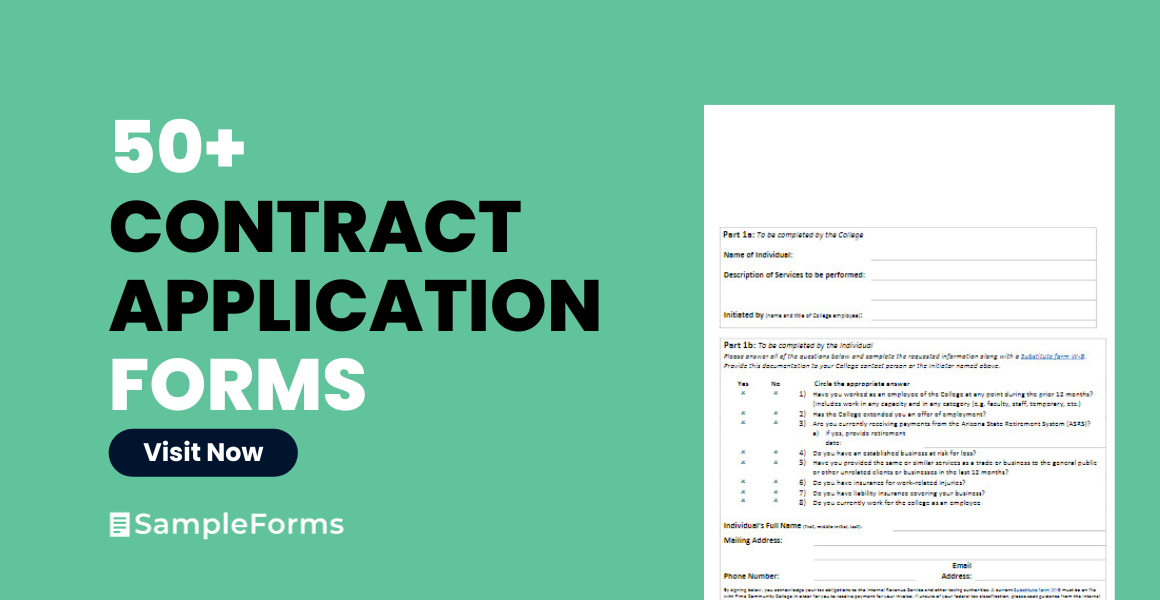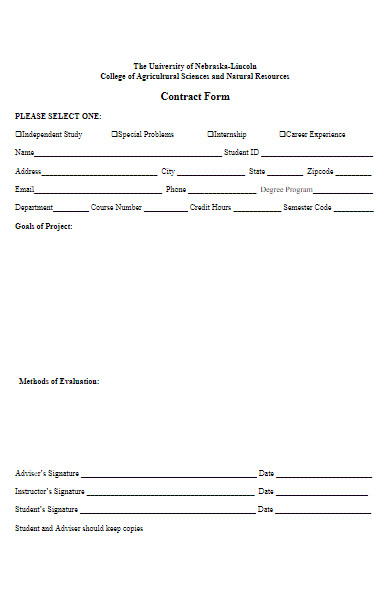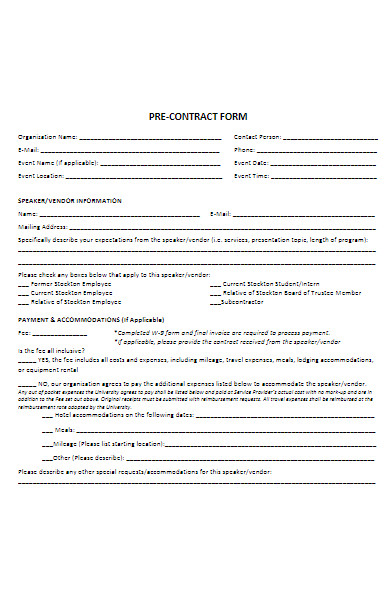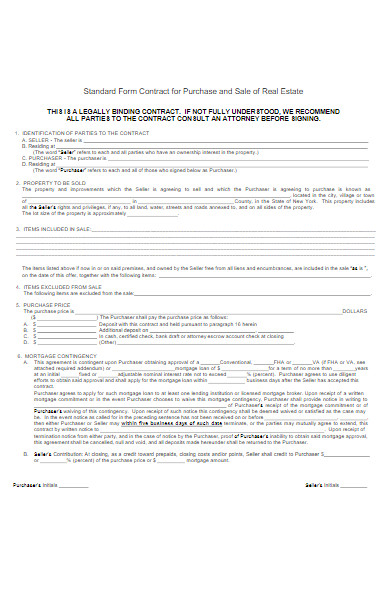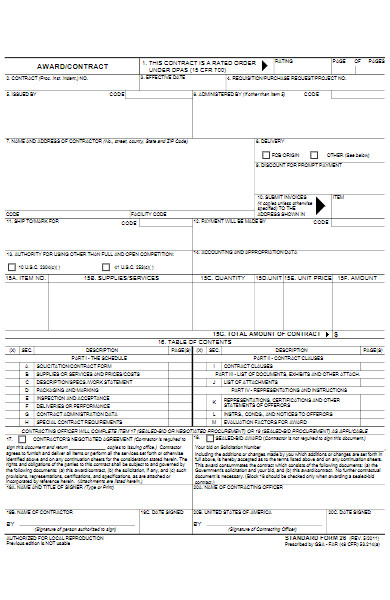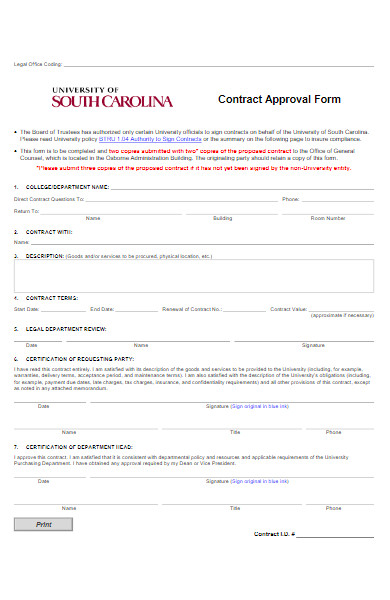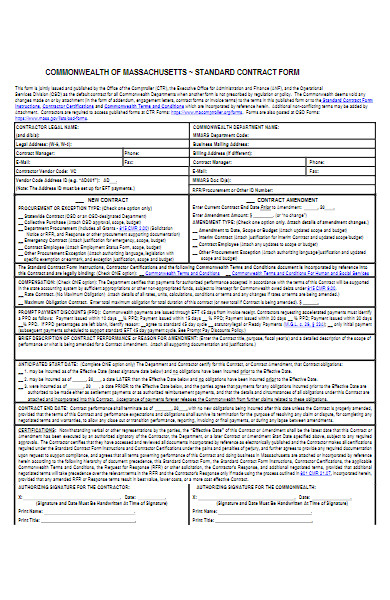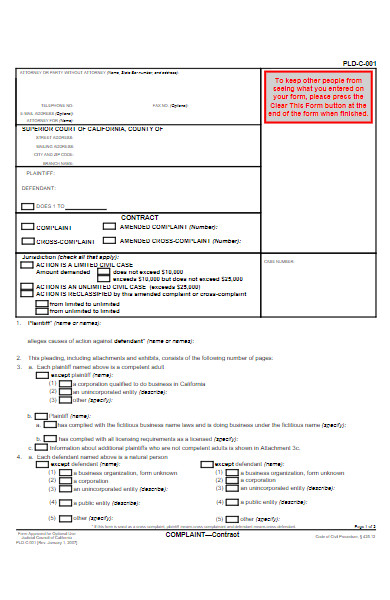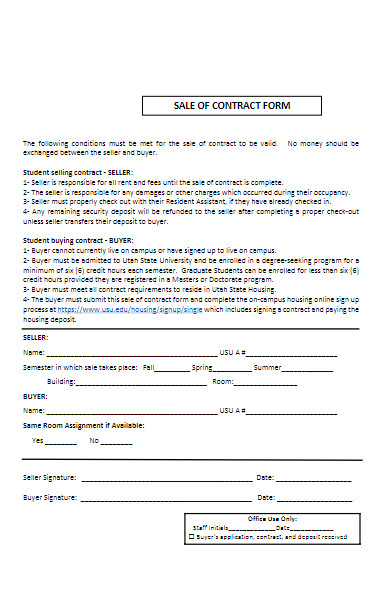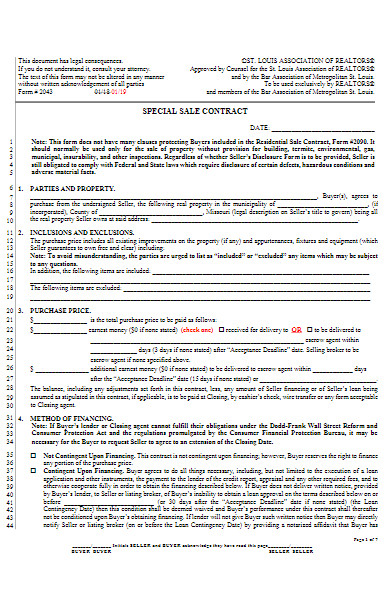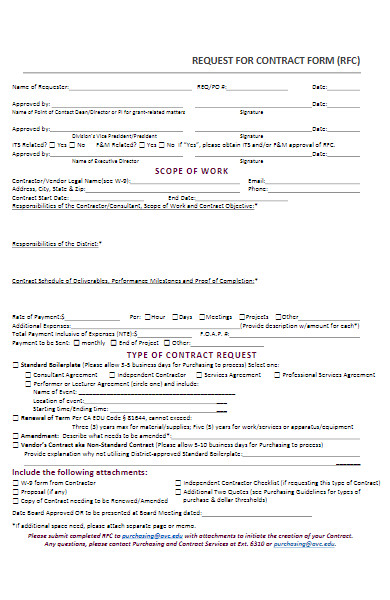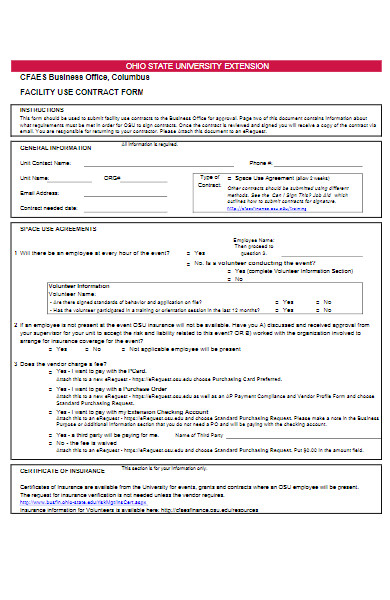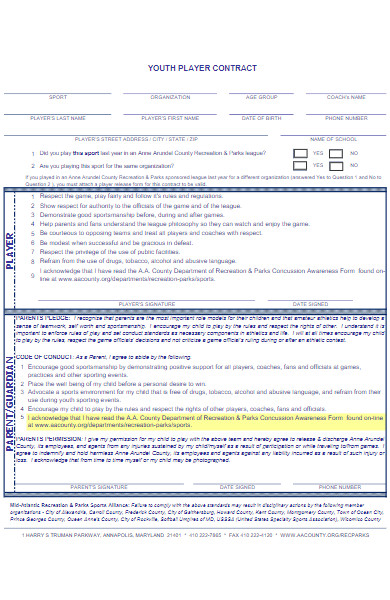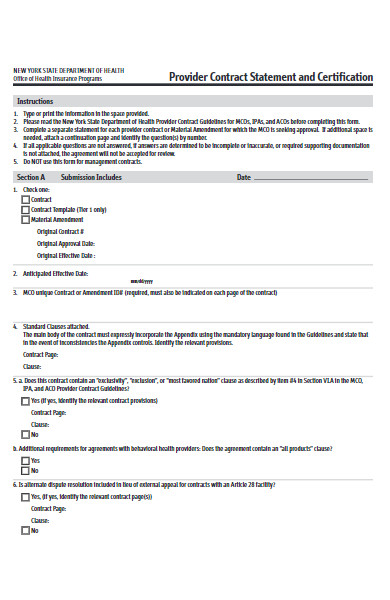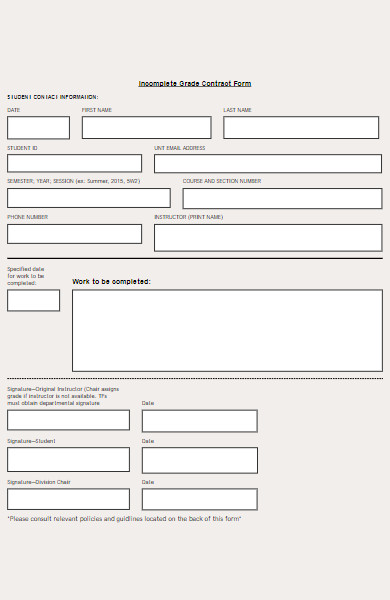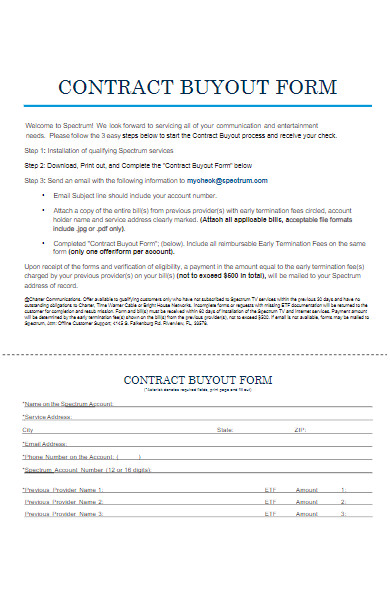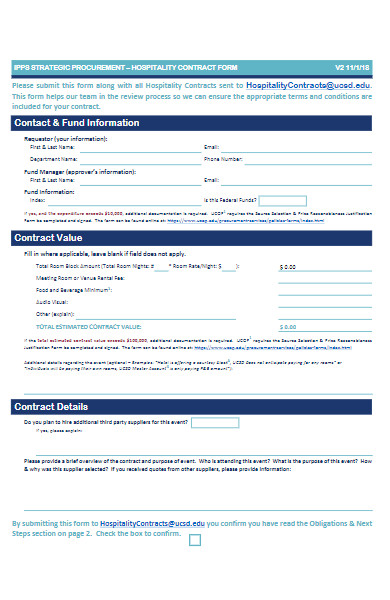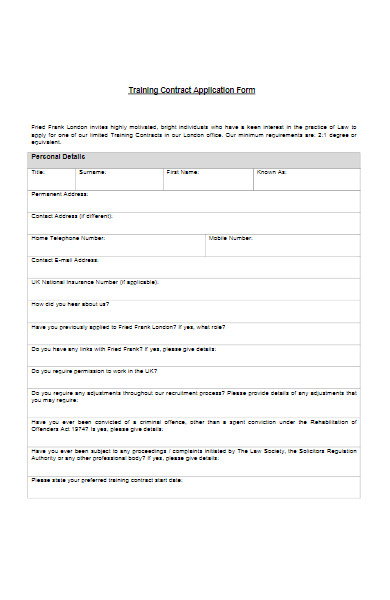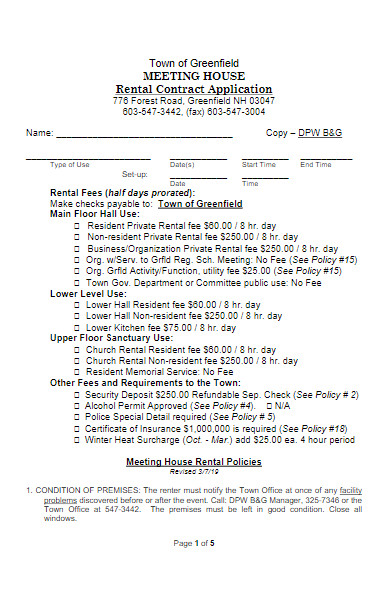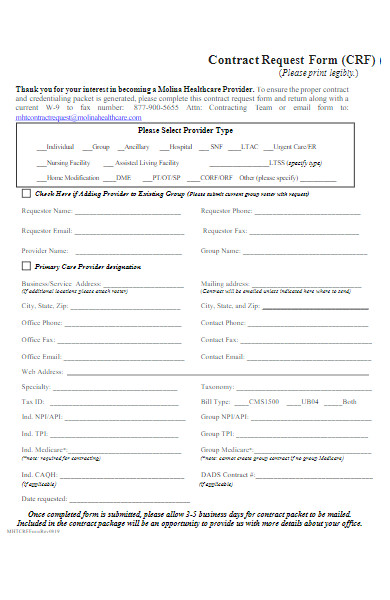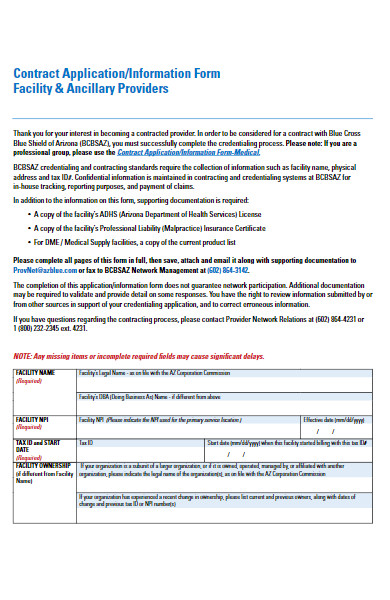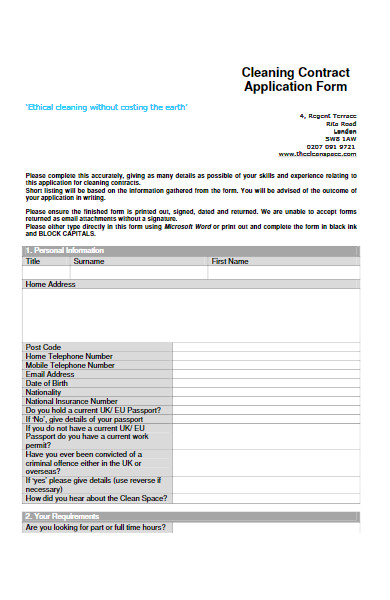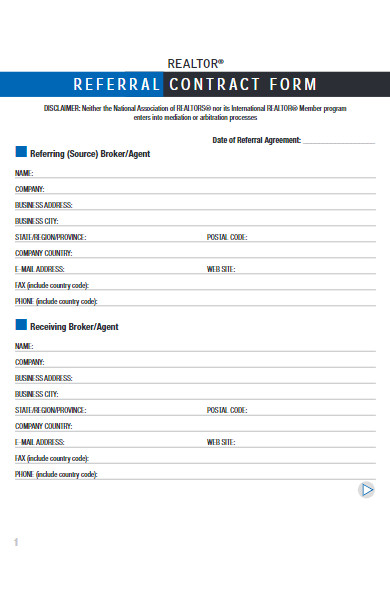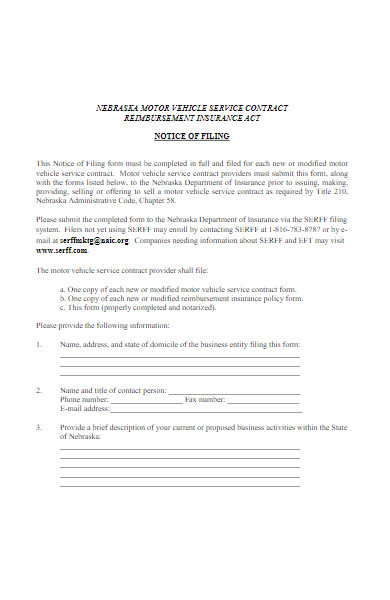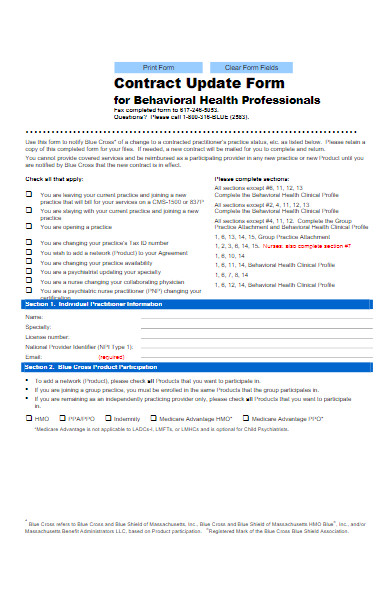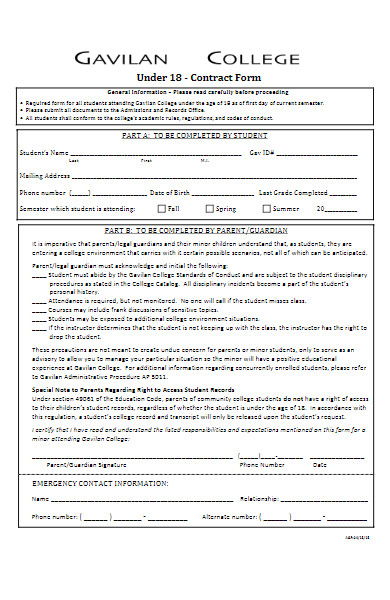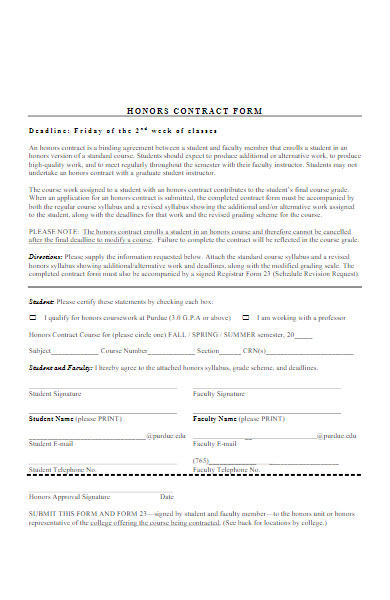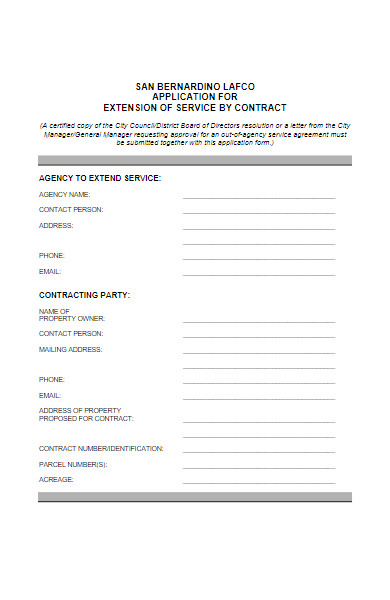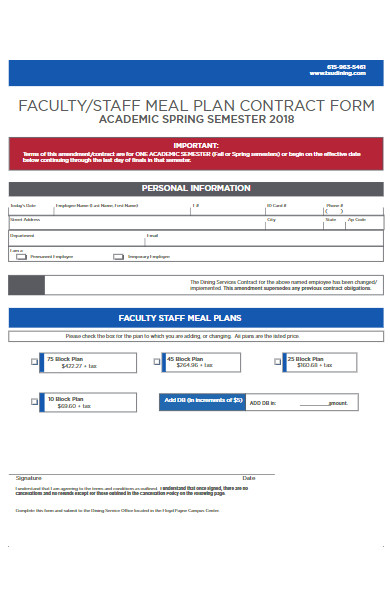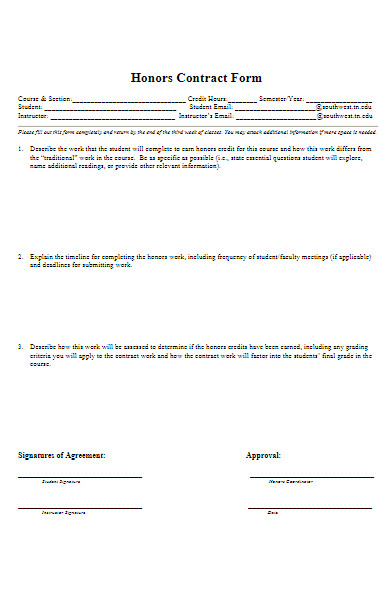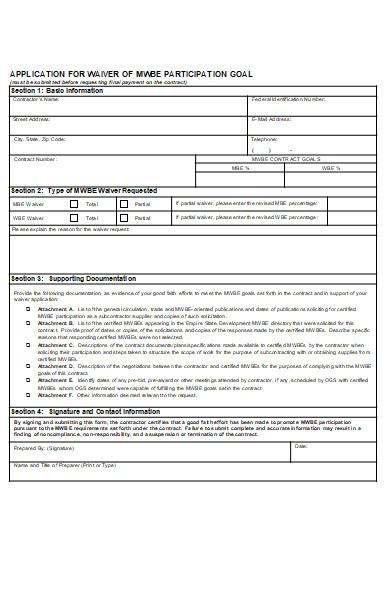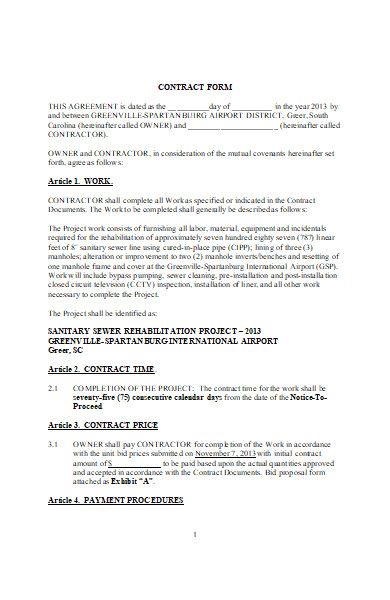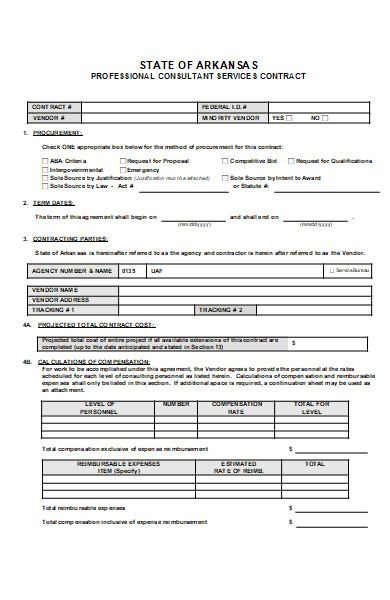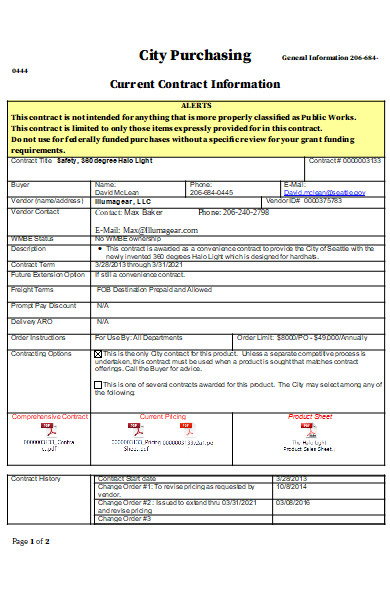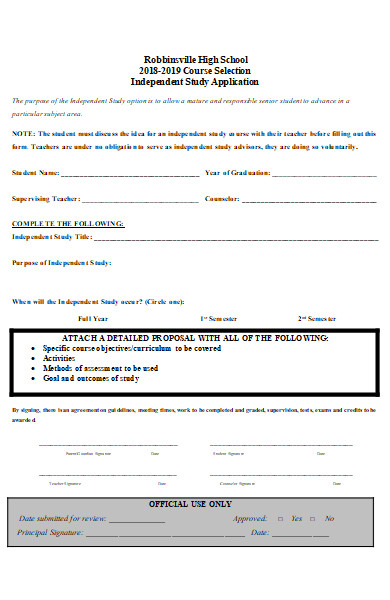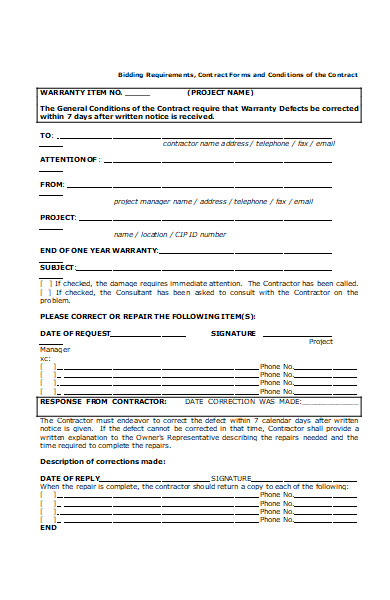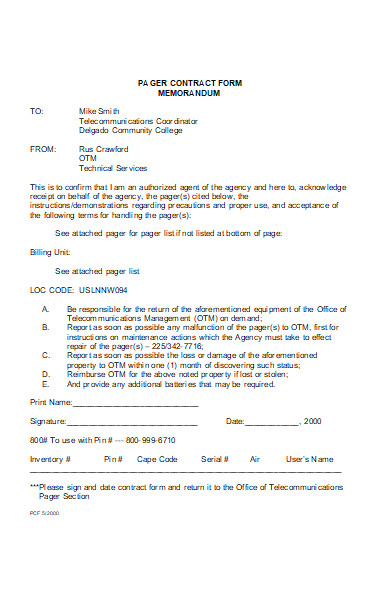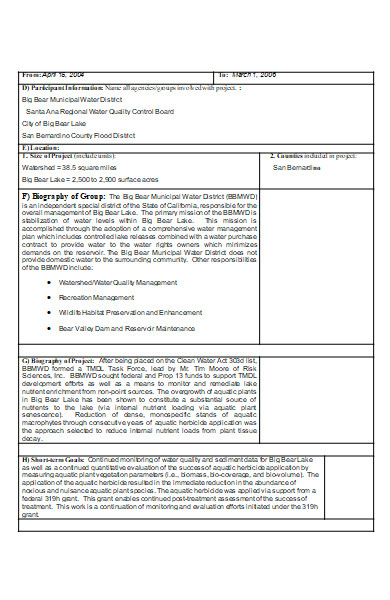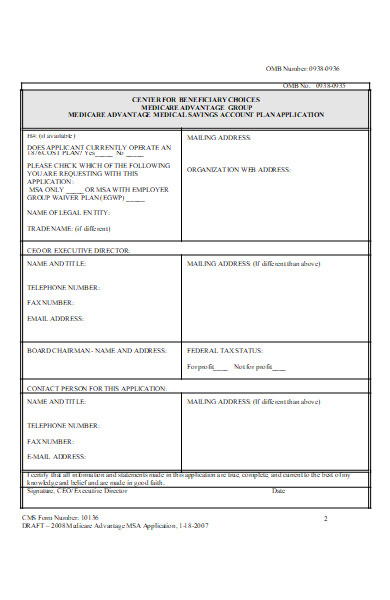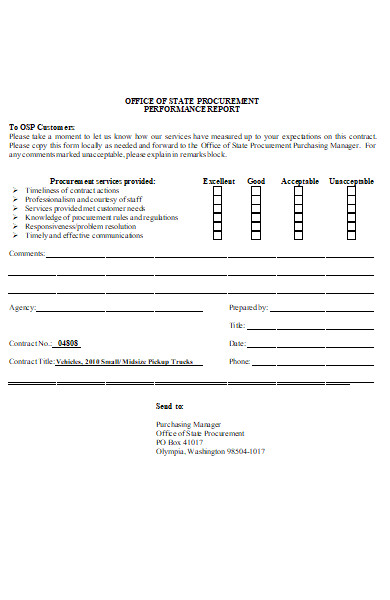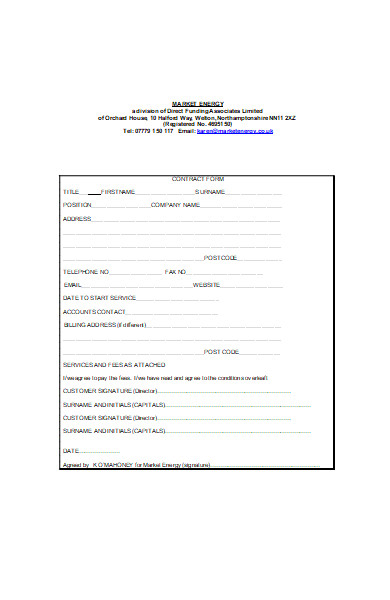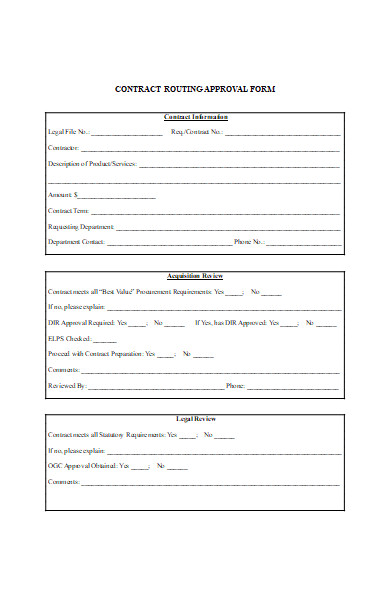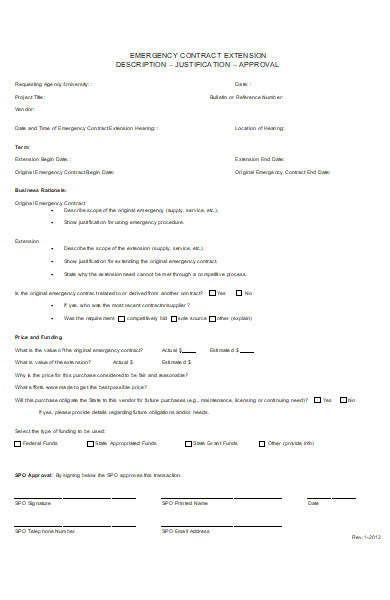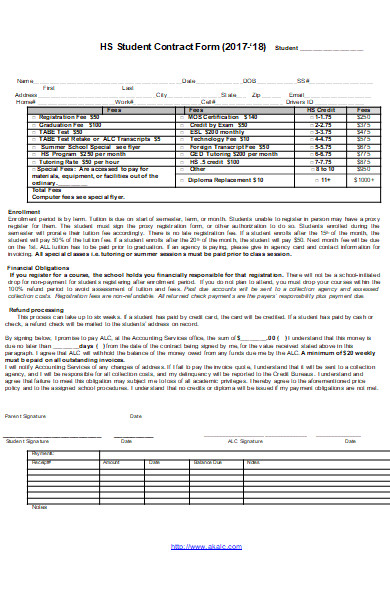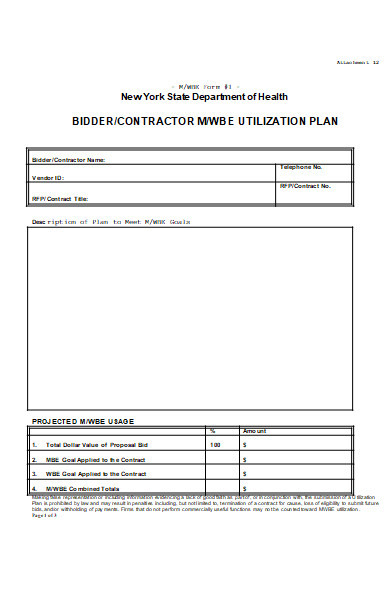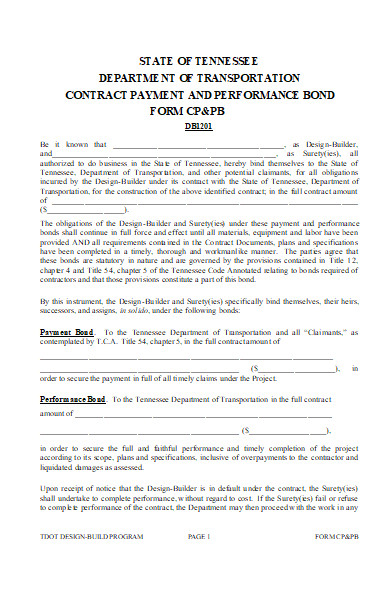A Contract Application Form acts as a bridge between potential contractors and entities seeking their services, facilitating a standardized vetting process. Whether it’s for a business looking to onboard a new service provider or an organization seeking specialized expertise, these forms play an essential role. Delving into its significance, the varied types available, practical examples, and best practices for creation can offer a holistic view, ensuring both parties are well-informed and the engagement begins on a solid foundation.
What is a Contract Application Form ? – Definition
A Contract Application Form is a standardized document used by organizations or individuals to collect pertinent information from potential contractors who wish to bid on or apply for specific contractual projects or services. These printable form typically captures details about the contractor’s qualifications, experience, references, and other relevant data. This allows the hiring entity to assess the contractor’s suitability for the job, ensuring that the best candidate is chosen based on merit, expertise, and alignment with project requirements.
What is the Meaning of a Contract Application Form?
The meaning of a Contract Application Form lies in its purpose and utility. It serves as an initial screening tool used by businesses or entities to gather essential details from potential contractors. By requiring applicants to provide standardized information, it ensures that all contractors are evaluated on a consistent set of criteria. These fillable form aids in narrowing down candidates, identifying their qualifications, experience, and capabilities. Essentially, it streamlines the process of selecting the most suitable contractor for a specific project or service, promoting transparency, fairness, and efficiency in the contractual engagement process.
What is the Best Sample Contract Application Form?
The best sample Contract Application Form will vary based on the specific needs of the organization or project. However, a comprehensive and effective form should cover several key areas. Here’s a generic example:
Organization/Company Name: [Text Field]
Address: [Text Field]
Contact Information:
- Phone: [Text Field]
- Email: [Text Field]
Contractor Details:
- Full Name: [Text Field]
- Business Name (if applicable): [Text Field]
- Address: [Text Field]
- Phone Number: [Text Field]
- Email Address: [Text Field]
Professional Background:
- Qualifications: [Text Field or Dropdown Options]
- Years of Experience: [Text Field or Slider]
- Specializations: [Text Field or Checkbox Options]
Previous Contracts/Projects:
- Project Name: [Text Field]
- Duration: [Text Field]
- Client: [Text Field]
- Brief Description: [Text Area]
[Option to add more projects]
References:
- Name: [Text Field]
- Contact Information: [Text Field]
- Relationship/Project: [Text Field]
[Option to add more references]
Proposed Terms (if applicable):
- Expected Remuneration: [Text Field]
- Duration of Contract: [Text Field]
- Other Terms: [Text Area]
Attachments:
- Resume/CV: [Upload Button]
- Portfolio or Work Samples: [Upload Button]
- Licenses/Certifications: [Upload Button]
Declaration:
I hereby confirm that all information provided is accurate and true to the best of my knowledge.
Signature: _________ Date: _________
This is a basic template, and modifications might be necessary based on industry, project scope, or other specific requirements. Always ensure that your form complies with relevant local laws and regulations, especially concerning data collection and privacy. You should also take a look at our contract forms.
FREE 50+ Contract Application Forms
51. Contract Bid Application Form
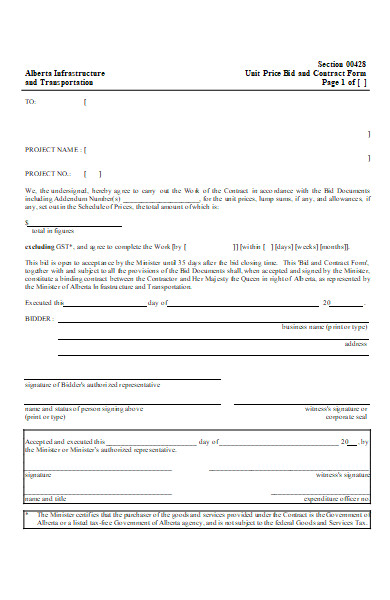
- MS Word
How to draft a Contract Application Form?
Drafting a Contract Application Form involves gathering essential details that will help assess an applicant’s suitability for a contractual engagement. Here’s a step-by-step guide on how to draft one:
-
Header:
- Title: Clearly mention “Contract Application Form” at the top.
- Date: Include a space for the applicant to fill in the date.
- Reference Number: If you use a tracking system, have a field for the application reference number.
-
Personal/Company Details:
- Full Name or Business Name
- Contact Address
- Phone Number
- Email Address
- Business Registration Number (if applicable)
-
Type of Contract:
- Specify whether it’s for services, goods, consultancy, etc.
- Provide a brief description or title for the contract.
-
Experience & Qualifications:
- Previous Contracts: List previous or ongoing contractual engagements.
- Relevant Certifications: Any certificates that demonstrate qualifications for the contract.
- References: Names and contact details of references from previous contracts.
-
Scope of Work:
- Description of the tasks, responsibilities, or deliverables the applicant proposes.
- Expected duration of the contract.
- Proposed milestones or phases, if applicable.
-
Financial Details:
- Proposed Contract Value: Estimated cost or bid value for the contract.
- Payment Terms: How the applicant expects to be compensated (e.g., upfront, installments, post-completion).
-
Terms & Conditions:
- A brief outline of any specific terms or conditions the applicant wishes to highlight or propose.
-
Attachments:
- A section that lists all necessary documents attached with the application, such as portfolio, licenses, or tax documents.
-
Declaration:
- A statement declaring that all provided information is accurate to the best of the applicant’s knowledge.
- Space for the applicant’s signature and date.
-
Submission Details:
- Instructions on where and how to submit the application.
- Deadline for submission.
- Footer:
- Confidentiality Clause: A note mentioning that the information in the application will be treated confidentially.
- Contact Details: Provide details for the department or person handling the applications for any queries.
Tips:
- Clarity: Use clear, straightforward language and avoid jargon.
- Consistency: Ensure fonts, headings, and bullet points are consistent throughout the document.
- Spacing: Leave ample space for applicants to fill in their details or attach additional sheets if necessary.
- Legality: Ensure you’re not asking for information that’s irrelevant or potentially discriminatory.
- Feedback: Before finalizing, have a few individuals in your network review the form for clarity and comprehensiveness.
Remember, the design and content of a Contract Application Form might vary depending on the industry, the nature of the contract, and specific organizational needs. Consulting with legal professionals can be helpful to ensure that the form meets all regulatory requirements. You should also take a look at our Contractor Application Forms.
Where can I find a free Contract Application Form template?
If you’re looking for a free Contract Application Form template, several online platforms and resources can assist you. Here are some places to start:
- Microsoft Office Templates: Microsoft Office has a range of templates for different purposes, including contract application forms. These can be accessed through Microsoft Word or Excel, or via their online platform.
- Google Docs/Sheets Templates: Google’s suite of office tools also provides users with a range of free templates, which can be customized as per your requirements.
- Legal Websites: Websites like Rocket Lawyer, LegalZoom, or LawDepot often offer free templates or samples for various legal documents, including contract application forms.
- Document Management Platforms: Websites like DocuSign, PandaDoc, or Formstack might offer templates as part of their services.
- Template Websites: Sites like Template.net, TidyForm, and JotForm have a plethora of document templates, including those for contracts.
- Government Websites: Depending on your jurisdiction or the nature of the contract, government or official regulatory websites may provide standard contract application forms or templates that meet legal standards.
- Industry Associations: Depending on your industry, there might be associations or organizations that offer standard templates to their members.
- Online Communities: Forums like Reddit, Stack Exchange, or industry-specific boards might have members sharing templates or directing you to resources.
When using any free template:
- Customize: Ensure you customize the template to fit your specific needs and to capture all the necessary information.
- Legality: Always consult with a legal professional to ensure the template meets legal standards and is suitable for your purpose.
- Update: Regulations and business needs change, so regularly review and update your form as necessary.
Note: While free templates can provide a good starting point, it’s essential to ensure they’re compliant with the laws and regulations specific to your industry and region. Always consult with a legal professional before implementing any agreement form in an official capacity.
Are Contract Application Forms legally binding?
A Contract Application Form itself is generally not legally binding. Instead, it’s a tool used to gather information from potential contractors and assess their suitability for a specific contractual engagement. The form helps in making informed decisions about which applicants to pursue further in the contractual process.
However, several aspects related to a Contract Application Form should be considered:
- Declaration & Signature: If the form contains a declaration that the information provided is accurate and truthful, and the applicant signs it, then any falsehoods or misrepresentations could have legal consequences, such as disqualification from the bidding process or potential legal action for fraud.
- Confidentiality: If the form or the related process includes clauses about confidentiality (for instance, regarding the information shared during the application process), then those clauses can be enforceable if both parties agree.
- Subsequent Agreements: While the application form itself isn’t binding, it may lead to a binding contract if the applicant is selected and both parties agree on terms. This subsequent agreement, often a formal contract, is what becomes legally binding.
- Terms & Conditions: If there are specific terms and conditions associated with the application process (like fees, requirements to provide certain documents, etc.), applicants might be expected to adhere to these as part of the application process, although they are typically not “binding” in the same way a formal contract would be.
- Data Protection: Depending on the jurisdiction, the way you handle, store, and use the information provided in the application form may be subject to data protection laws. It’s essential to ensure that personal or sensitive data is handled appropriately.
It’s crucial for organizations to make clear in their application forms what, if any, parts of the document or process might have legal implications. And as always, consulting with legal professionals when designing, implementing, or interpreting a Contract Application Form is recommended. Our Contract form is also worth a look at
What details should be included in a Contract Application Form?
A Contract Application Form is designed to gather relevant details to assess an applicant’s suitability for a contractual engagement. Here are the key details and sections that should typically be included:
- Header:
- Title: Clearly label the document as “Contract Application Form.”
- Date: Field for the applicant to input the date of submission.
- Reference Number: If you use a system to track applications, include a field for it.
- Personal/Company Details:
- Full Name or Business Name
- Contact Address
- Phone Number
- Email Address
- Business Registration Number (if applicable)
- Contract Details:
- Type of Contract: Specify the nature of the contract, such as services, goods, consultancy, etc.
- Description or Title of Contract: A brief title or description about the intended work.
- Experience & Qualifications:
- Previous Contracts: Ask for details on past or ongoing contractual engagements.
- Relevant Certifications: Certificates or qualifications pertinent to the contract.
- References: Include fields for names and contact details of previous clients or business partners.
- Scope of Work:
- Description: Allow space for applicants to describe their proposed tasks, responsibilities, or deliverables.
- Duration: Expected length or term of the contract.
- Milestones or Phases: If applicable, let applicants list key project milestones.
- Financial Details:
- Proposed Contract Value: Field for the estimated or bid amount for the contract.
- Payment Terms: How the applicant expects to be paid (e.g., upfront, in milestones, after completion).
- Terms & Conditions:
- A section where the applicant can list any specific terms or conditions they wish to propose or highlight.
- Attachments:
- List of Required Documents: Clearly mention what documents, certifications, or proofs the applicant needs to attach.
- Space for Additional Notes: A field where applicants can mention or list other documents they’ve attached for consideration.
- Declaration:
- A statement where the applicant declares that all provided information is accurate. This section usually requires a signature and date.
- Submission Details:
- Clearly state where and how the application form should be submitted.
- Mention any deadline or due date for submission.
- Confidentiality Clause (if applicable):
- A statement mentioning that the details provided will be kept confidential and outlining any conditions related to the sharing or use of the information.
- Feedback or Follow-Up:
- Information on when and how applicants will be informed about the status of their application.
It’s essential to customize the Contract Application Form based on the specific requirements of the industry, the nature of the contract, and the organizational needs. Ensure that the form is clear, concise, and easy to fill out. Always consult with legal professionals when designing the form to ensure all necessary components are included and that it adheres to relevant laws and regulations. In addition, you should review our Sample Employment Contract Forms.
How do I submit a Contract Application Form online?
Submitting a Contract Application Form online typically involves a combination of preparing your form digitally and using a platform or system through which the form can be received by the intended party. Here’s a step-by-step guide to help you submit a Contract Application Form online:
-
Prepare the Form Digitally:
- If you’ve received or downloaded a fillable PDF or Word document, fill in the necessary fields directly on the digital file.
- If you have a physical copy of the form, you can scan it to create a digital version. Once scanned, there are various tools available that allow you to add text to scanned PDFs.
-
Collect Required Attachments:
- Scan or gather digital copies of any necessary attachments, such as resumes, certifications, or other required documents.
- Ensure that all documents are clearly named so that they can be easily identified.
-
Use a Secure Online Platform:
- Organization’s Website/Portal: Many organizations have dedicated portals where you can upload and submit forms and attachments.
- Email: If the organization accepts submissions via email, attach your form and all relevant documents to the email. Ensure you use a secure and reliable email provider. Remember to follow any specific instructions about subject lines or email content.
- Document Submission Platforms: Some organizations might use platforms like DocuSign, Dropbox, Google Forms, or other cloud services to collect applications.
- Specialized Contracting Platforms: For some industries, there may be dedicated platforms for submitting contract applications, such as procurement platforms.
-
Encrypt Sensitive Data:
- If you’re submitting sensitive information, consider encrypting your files before submission. You can use software like 7-Zip or WinRAR to create password-protected zip files. Remember to share the password securely (e.g., via a phone call).
-
Follow Submission Instructions Carefully:
- Always adhere to any guidelines or instructions provided by the organization. This can include naming conventions for files, size limits, preferred formats (e.g., PDF vs. DOC), and more.
-
Confirmation & Tracking:
- After submitting, you should receive a confirmation of receipt. If not, follow up to ensure your application was received.
- If the platform provides tracking options (like a submission ID or status updates), make sure to keep that information for future reference.
-
Backup Your Submission:
- Always keep a copy of everything you’ve submitted. This is useful for your records and in case any issues arise with the submission.
-
Stay Safe Online:
- Only submit applications to known and trusted organizations.
- Be cautious about phishing attempts or fake websites that mimic legitimate organizations.
- Use strong, unique passwords for any accounts associated with the submission process.
By following these steps and ensuring you’re using secure and trusted platforms, you can successfully and safely submit your Contract Application Form online.
What is the purpose of a Contract Application Form?
A Contract Application Form serves several essential purposes in the contractual and procurement processes:
- Information Collection: It’s a standardized way for organizations to collect relevant details about potential contractors or vendors. This can include information about the contractor’s experience, qualifications, financial stability, and proposed terms.
- Assessment & Evaluation: By having a standardized form, organizations can more easily compare and assess different applicants. It ensures that everyone is providing the same set of information, making the evaluation process more efficient and equitable.
- Documentation & Record-Keeping: These forms become part of the official record. They can be referred back to if there are questions about what was proposed or promised, and they can be kept for future reference if the need for similar contracts arises.
- Setting Expectations: The form can outline what is expected from applicants, ensuring that only those who meet specific criteria will apply.
- Risk Management: By collecting key information about potential contractors or vendors, organizations can identify and mitigate potential risks. This can be especially important in industries or situations where safety, financial stability, or other significant concerns need to be addressed.
- Efficiency: A standardized application process can streamline the procurement or contracting process, making it quicker for organizations to identify and engage with potential partners.
- Transparency: Especially in public or governmental contexts, having a formalized application process can enhance transparency, ensuring that contracts are awarded based on merit and predefined criteria, rather than favoritism or other non-objective factors.
- Legal & Regulatory Compliance: In many sectors, there are legal or regulatory requirements for how contracts must be awarded. A standardized Contract Application Form can ensure that organizations remain compliant by collecting all necessary information and adhering to prescribed processes.
- Setting the Stage for Formal Agreements: The information collected in the application form can later be incorporated into a formal contract, reducing the back-and-forth and negotiation that might otherwise be needed.
- Building Trust: A formalized and transparent application process can help build trust between organizations and potential contractors or vendors. It signals professionalism and a commitment to objective, fair practices.
In summary, a Contract Application Form is a critical tool in the contracting and procurement processes. It provides a structured, objective, and efficient way for organizations to gather information, evaluate potential partners, and establish the foundations for successful contractual relationships. You may also be interested in our Legal Application Form.
How often should I update my Contract Application Form?
The frequency with which you should update your Contract Application Form depends on several factors, but here are some general guidelines:
- Regulatory Changes: If there are changes in laws or regulations that pertain to your industry or the nature of the contracts you’re offering, you should update your form immediately to ensure compliance.
- Industry Standards: As industry best practices evolve, your form should reflect these changes to remain competitive and relevant.
- Organizational Changes: If there are significant shifts in your organization’s structure, policies, or processes, these might necessitate updates to the application form.
- Feedback: If you receive consistent feedback from applicants about certain sections of the form being unclear or redundant, consider revising for clarity and efficiency.
- Technological Advancements: As new technologies emerge, they can offer more efficient ways to gather or verify information. For instance, integration with digital verification tools or the adoption of e-signature capabilities might necessitate updates to your form.
- Frequency of Use: If you’re using the Contract Application Form frequently (e.g., monthly or quarterly), it’s a good idea to review and potentially update it annually. If you use it less frequently, you might review it every 2-3 years.
- Historical Data Analysis: If, upon review of submitted applications over time, you notice patterns of missing or inconsistent information, it might be an indication that certain sections of your form need to be revised for clarity or relevance.
- Changes in Contract Offerings: If the types or nature of the contracts you’re offering change, ensure your form reflects these changes.
- Post-Contract Evaluations: If after awarding contracts, you frequently encounter issues that could have been identified or mitigated through the application process, consider revising your form to address these gaps.
- Market Dynamics: If there are significant shifts in market conditions, competition, or client needs, these might require changes to how you evaluate potential contractors.
In general, even if none of the above factors are pressing, it’s a good practice to review your Contract Application Form at regular intervals (e.g., annually) to ensure it remains relevant, effective, and compliant. Regular reviews will help ensure that your form continues to serve its purpose and meet the evolving needs of both your organization and potential contractors. You can also browse our Construction Application Forms.
How to Create a Contract Application Form?
Creating a Contract Application Form requires careful thought to ensure it captures all the necessary information and aligns with legal and organizational requirements. Here’s a step-by-step guide to help you develop an effective form:
-
Determine the Purpose:
- Identify the primary purpose of the contract. Is it for vendor selection, freelance services, partnership agreements, or another purpose?
- Decide what kind of information is essential for decision-making.
-
Gather Organizational Requirements:
- Consult with relevant departments (e.g., legal, procurement, HR) to understand internal requirements.
- Determine if there are specific criteria or qualifications that applicants must meet.
-
Research Legal & Regulatory Requirements:
- Ensure that your form complies with local, state, and federal laws.
- For certain industries or types of contracts, there might be specific regulatory requirements to consider.
-
Choose a Format:
- Decide on the layout. Will it be a digital form, a downloadable PDF, a fillable online form, or a printed document?
- Consider user-friendliness. Ensure it’s easy for applicants to understand and complete.
-
Draft the Form:
- Header: Include your organization’s name, logo, and contact details.
- Introduction: Provide a brief description of the contract opportunity and the purpose of the application form.
- Personal & Business Details: Capture applicant’s name, business name, contact information, and other relevant details.
- Qualifications & Experience: Ask about the applicant’s qualifications, previous experience, references, etc.
- Proposal Details: If relevant, have a section where applicants can outline their proposal, pricing, timelines, etc.
- Certifications & Compliance: Ensure that applicants acknowledge any necessary certifications or compliance requirements.
- Terms & Conditions: Include any standard terms or conditions that applicants should be aware of.
- Signatures: Provide a space for applicants to sign, indicating their understanding and agreement.
-
Add Supplementary Sections:
- Depending on the contract’s nature, you might need sections on financial information, insurance details, equipment or technology capabilities, etc.
-
Include a Checklist:
- If applicants need to attach additional documents (e.g., resumes, business licenses, portfolios), include a checklist to ensure they provide all necessary materials.
-
Review & Test:
- Before finalizing, have multiple team members review the form for clarity, comprehensiveness, and accuracy.
- Consider doing a test run with a small group to gather feedback and make any necessary adjustments.
-
Incorporate Feedback:
- Make adjustments based on the feedback received to ensure the form is user-friendly and captures all required information.
-
Distribute & Implement:
- Once finalized, make the form available to potential applicants. This could be through your website, via email, or through industry platforms.
- Ensure relevant teams are trained on how to process and evaluate the completed forms.
- Review Periodically:
- As with any important document, periodically review and update the form to reflect changes in organizational needs, industry standards, or regulatory requirements.
By following this guide and tailoring it to your organization’s specific needs and context, you can create a Contract Application Form that effectively captures all necessary information, streamlines the application process, and facilitates informed decision-making. You may also be interested to browse through our other Job Application Forms.
Tips for creating an Effective Contract Application Form
Creating an effective Contract Application Form requires attention to detail and an understanding of what both the organization and the applicant need. Here are some tips to ensure your form is as effective as possible:
-
Keep it Simple and Clear:
- Avoid jargon and complex language. Use straightforward and concise wording to ensure applicants understand what’s being asked of them.
-
Logical Flow:
- Organize sections in a logical order, starting with basic information and progressing to more detailed questions.
-
Use Consistent Formatting:
- Maintain consistent fonts, font sizes, and spacing throughout. This not only looks professional but also makes the form easier to read.
-
Provide Instructions:
- Wherever necessary, include brief instructions or examples to guide applicants on how to fill out specific sections.
-
Incorporate Drop-Downs and Checkboxes:
- For digital forms, using drop-down menus and checkboxes can simplify the process for applicants and ensure you receive standardized responses.
-
Include Mandatory Fields:
- Clearly indicate which fields are mandatory. This helps ensure that you receive all the necessary information.
-
Limit Open-Ended Questions:
- While some open-ended questions can be valuable, having too many can make the form cumbersome. Use them judiciously.
- Protect Sensitive Data:
- If you’re collecting sensitive data, ensure the form is secure, and inform applicants of how their data will be used and stored.
-
Make It Mobile-Friendly:
- If your form is online, ensure it’s responsive and easy to fill out on both desktop and mobile devices.
-
Allow Save and Return:
- For longer forms, provide an option for applicants to save their progress and return later.
-
Provide Contact Information:
- Include a contact point (email or phone) for applicants who have questions or face issues while filling out the form.
-
Seek Feedback:
- Regularly gather feedback from both users of the form and internal teams to understand areas of improvement.
-
Include a Review & Confirmation Step:
- Before submission, allow applicants to review their responses and confirm accuracy.
-
Automate Where Possible:
- If you receive large volumes of applications, consider automating certain steps, like data validation or preliminary screening.
-
Stay Updated:
- Regularly update the form to reflect changes in organizational needs, industry standards, or regulatory requirements.
-
Include a Disclaimer or Terms of Submission:
- Clearly state the terms of submission, especially if there are legal implications, to ensure transparency and protect your organization.
-
Provide a Submission Confirmation:
- Once the form is submitted, provide a confirmation message or email to assure applicants that you’ve received their information.
By incorporating these tips and customizing them to your specific needs and context, you can create a Contract Application Form that streamlines the application process, ensures you capture all the necessary data, and provides a positive experience for applicants.
A Contract Application Form is a pivotal tool used by organizations to gather essential data from potential contractors or partners. It streamlines the selection process by capturing relevant information in a standardized format. While its structure can vary based on purpose and industry, creating an effective form requires clarity, simplicity, and a focus on both organizational and applicant needs. Regular updates ensure its continued relevancy and efficacy. Our Training Application Form is also worth a look at
Related Posts
FREE 31+ Printable Application Forms in PDF Ms Word | Excel
FREE 9+ Standard Job Application Forms in PDF MS Word | Excel
FREE 9+ Vendor Agreement Forms in PDF MS Word
FREE 6+ Sample Landlord Tenant Forms in PDF MS Word
FREE 11+ Security Application Forms in PDF MS Word
FREE 50+ Employment Forms in PDF MS Word | Excel
FREE 8+ Sample Rental Forms in MS Word PDF | ExcelFREE 8+ ...
FREE 8+ Renewal Application Forms in PDF Ms Word
FREE 9+ Sample Rental Contract Forms in PDF MS Word
FREE 10+ Sample Job Application Forms in MS Word PDF | Excel
FREE 14+ Sample Membership Application Forms in PDF Word ...
FREE 8+ Sample Transportation Contract Forms in PDF MS Word
FREE 11+ Contractor Application Forms in PDF Excel
FREE 10+ Sample Contractor Application Forms in PDF Excel | MS ...
FREE 7+ Sample Supply Contract Forms in PDF MS Word
